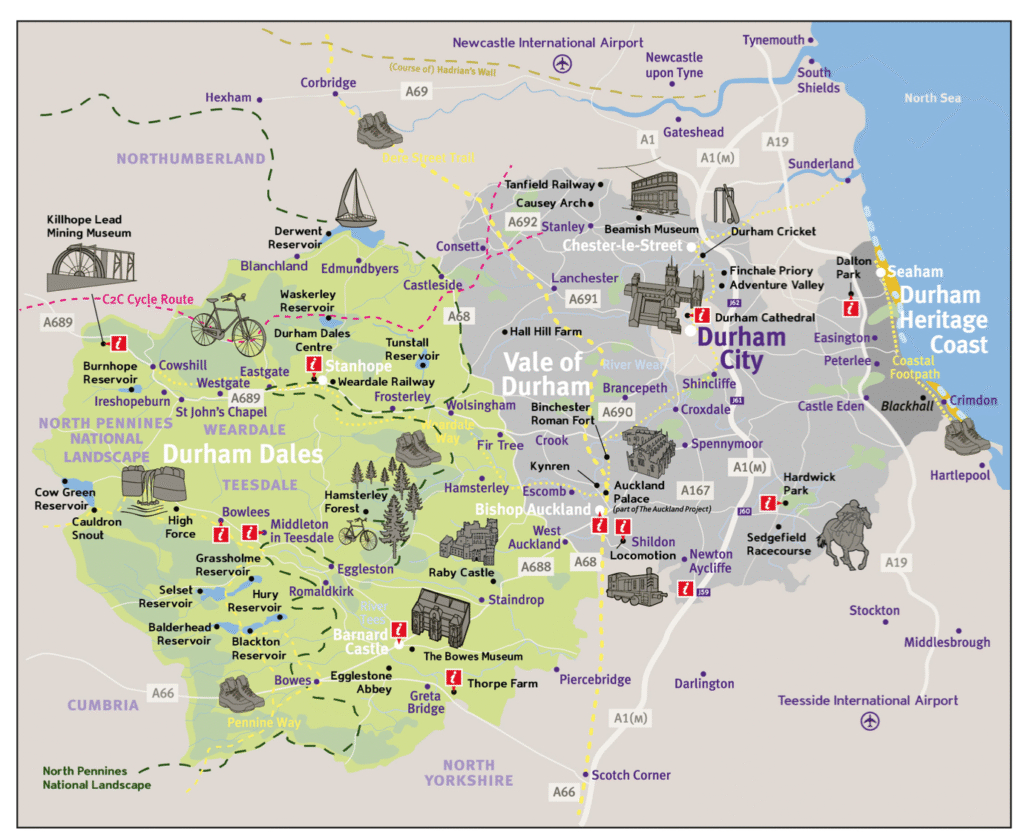Join the Weather Lovers Community at Skool
County Durham—my own stomping ground. It’s a place that doesn’t get nearly enough credit for its beauty, charm, and personality.
Tucked neatly between Northumberland to the north and Yorkshire to the south, it’s one of those places in England where the landscape changes every few miles, and you’re never far from either a rugged hill, a windswept coastline, or a village pub serving real ale and top-tier pork scratchings.
Let’s start with the basics:
County Durham lies in the North East of England and covers a diverse area stretching from the North Pennines in the west, to the North Sea coast in the east.
You’ve got moors, dales, farmland, forests, and even a few glorious sandy beaches thrown in for good measure. It’s like a sampler platter of British geography, minus the Scottish Highlands or Cornish coves.
Now, on to the towns and cities—because let’s face it, the land is gorgeous, but it’s the people and places that bring it to life.
Durham City is the jewel in the county’s crown, and its capital. With its cathedral perched on a hill like something out of a fantasy novel.
It’s compact, charming, and smugly intellectual thanks to the university.
The city itself sits in a river loop of the River Wear, and the surrounding geography is quite hilly.
That makes for lovely views and a great workout if you’re walking around town. As for the weather – well, like most of County Durham, it tends to be a little cool and damp.
But Durham gets a lot less rain than the west of the county. It’s sheltered enough that you can get away with a decent coat and an umbrella you won’t instantly regret opening.
Head east, and you’ll find Peterlee and Seaham, coastal towns with a more industrial past. Seaham in particular has seen a bit of a glow-up in recent years.
The beach is now a haven for sea glass collectors, dog walkers, and the odd photographer pretending they aren’t freezing.
The sea air can be pretty bracing, and the climate here is milder in winter compared to inland, thanks to the sea’s influence, but that also means more cloud and drizzle.
It’s not quite ‘wet towel slapped in the face’ weather, but can come close.
Darlington, down in the south of the county, has a different vibe altogether.
Historically it was a major railway town, the birthplace of the world’s first passenger railway, no less, so it takes transport rather seriously.
The geography here flattens out a bit; you’re getting into Tees Valley territory.
Weather-wise, Darlington sees more sunshine than the western hills, but that also means it’s slightly more prone to dry spells in summer and frost in winter.
Bishop Auckland sits in the Wear Valley and acts as a sort of halfway point between the city of Durham and the wilder west. It’s a market town with a growing arts and culture scene.
The Auckland Project’s been giving the place a shot in the arm lately. It’s surrounded by countryside, and when you head west from here, you’re soon climbing into Weardale and the North Pennines, an Area of Outstanding Natural Beauty.
Translation: it’s gorgeous, remote, and about three degrees colder than anywhere else in the county.
Winters here are proper winters; snow that actually settles, icy winds, and roads that disappear under a pile of white at the first opportunity.
But come summer, the place turns into something out of a postcard. Rolling green hills, wildflower meadows, and a sky that (if you’re lucky) turns blue.
Then there’s Newton Aycliffe and Spennymoor, both newer towns compared to the ancient roots of Durham City. Newton Aycliffe is one of those post-war new towns, built with industry in mind, and still home to quite a bit of manufacturing.
The geography here is flatish, and the weather fairly standard for inland Durham. Coolish summers, chilly winters, and the odd glorious day where the sun actually shows up and we all panic-buy BBQs.
In the north, you’ve got Chester-le-Street, which sits between Durham and Newcastle. It’s got a decent cricket ground and good train connections, and while it’s often overshadowed by its neighbours, it’s a solid place.
The River Wear runs through here too (downstream from Durham), and the land around is fairly rolling. The climate’s similar to Durham City, although it’s nearer the coast, so more prone to coastal fog.
The big climate divide in County Durham is simple: the west is higher and wilder, so it’s colder, wetter, and snowier.
The east, especially by the coast, is a bit milder and breezier, thanks to the North Sea. The middle? Well, it’s a bit of a mix.
You’ll get everything from surprise hail in June to t-shirt weather in March, but never for long.
So there you have it. County Durham: a land of cathedrals and collieries, castles and coastlines. It’s not flashy, but it’s got character. And weather that builds it.
Ever visited somewhere in County Durham and been totally surprised by how different it felt from what you expected?
Or do you have a favourite Durham hidden gem worth shouting about?
Join the Weather Lovers Community at Skool

